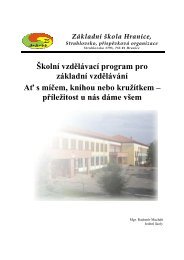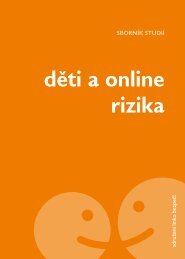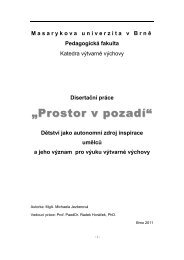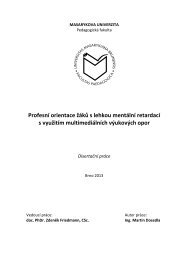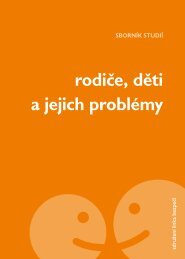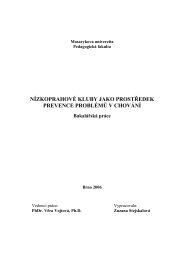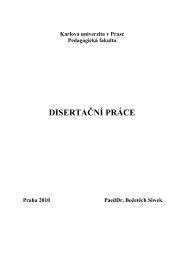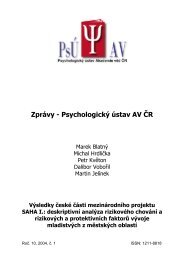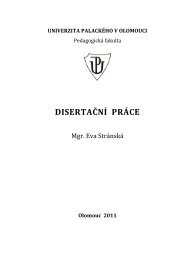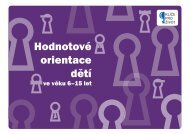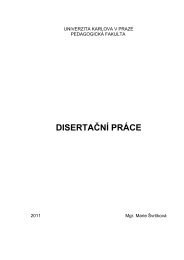Aspinwall, L. G. (2005).The psychology <strong>of</strong> future-oriented thinking: from achievement to proactivecoping, adaptation, and aging. Motivation and Emotion, 29, 203-234.doi: 10.1007/s11031-006-9013-1Aspinwall, L. G., & Clark, A. (2005). Taking positive changes seriously: toward a positivepsychology <strong>of</strong> cancer survivorship and resilience. Cancer, 104, 2543-2645. doi: 10.1002/cncr.21244Aspinwall, L. G., & MacNamara, A. (2005).Taking positive changes seriously. Cancer Supplement, 104,2549-2556. doi:10.1002/cncr.21244Aspinwall, L. G., & Taylor, S. E. (1997). A stitch in time: self-regulation and proactive coping.Psychological Bulletin, 121, 417-436.Získané z http://www.ncbi.nlm.nih.gov/pubmed/9136643Atkinson, R. L. (2003). Psychologie. Praha: Portál.Austin, E. J. (2010). Measurement <strong>of</strong> ability emotional intelligence. Results for two new tests. BritishJournal <strong>of</strong> Psychology, 101, 563–578. doi: 10.1348/000712609X474370Austin, E. J., Farrelly, D., Black, C., & Moore, H. (2007). Emotional intelligence, Machiavellianism andemotional manipulation: Does EI have a dark side? Personality and Individual Differences, 43, 179–189. doi: 10.1016/j.paid.2006.11.019Austin, E. J., Parker, J. D. A., Petrides, K. V., & Sakl<strong>of</strong>ske, D. H. (2008). Emotional intelligence. In G. J.Boyle, G. Matthews, & D. H. Sakl<strong>of</strong>ske (Eds.), The SAGE handbook <strong>of</strong> personality theory andassessment (pp. 576–596). London: SAGE. ISBN:9781412946520Austin, E. J., Sakl<strong>of</strong>ske, D. H., & Egan, V. (2005). Personality, well-being and health correlates <strong>of</strong> traitemotional intelligence. Personality and Individual Differences, 38, 547-558.doi:10.1016/j.paid.2004.05.009Averill, J. R. (2004). A tale <strong>of</strong> two snarks: Emotional intelligence and emotional creativity compared.Psychological Inquiry, 15, 228-233. Získané http://www.jstor.org/discoverBačová, V. (2003). Osobná identita – konštrukcie – <strong>text</strong> – hladanie významu. In I.Čermák,M.Hřebíčková & P. Macek, (Eds.), Agrese, identita, osobnost. Brno: Psychologický ústav AV ČR,Tišnov: Sdružení SCAN.Bagley, C. A., & Carroll, J. (1998). Healing forces in African American families. In H. I. McCubbin, E. A.Thompson, A. I. Thompson, & J. A. Futrell (Eds.), Resiliency in African American families (pp. 117–142). Thousand Oaks, CA: Sage. ISBN: 9780761913931Bargh, J. A., & Gollwitzer, P. M. (1994). Environmental control <strong>of</strong> goaldirected action: Automatic andstrategic contingencies between situations and behavior. In W. D. Spaulding (Eds.), Integrative views<strong>of</strong> motivation, cognition, and emotion. Nebraska symposium on motivation (Vol. 41) (pp. 71-124).Lincoln: University <strong>of</strong> Nebraska Press.Bar-On, R. (1997). Bar-On Emotional Quotient Inventory: User’s manual. Toronto: Multi-HealthSystems. Získané z http://www.hpsys.com/BarOn_EQi.htm144
Bar-On, R. (2000). Emotional and social intelligence: Insights from the Emotional Quotient Inventory.In R. Bar-On & J. D. A. Parker (Eds.), The handbook <strong>of</strong> emotional intelligence (pp. 363–388). SanFrancisco, CA: Jossey-Bass.Bar-On, R.(2004). The Bar On emotional quotient inventory (EQ-I): Rationale, description andsummary <strong>of</strong> psychometric properties. In: G. Geher (Eds.), Measuring emotional intelligence:Common ground and controversy (pp.112-141). Hauppage: Nova Science. ISBN: 1-59454-080-2Bar-On, R. (2005). The Bar-On Model <strong>of</strong> Emotional-Social Intelligence (ESI), Psicothema,18, 13-25.Získané z http://redalyc.uaemex.mx/pdf/727/72709503.pdfBar-On, R. (2007). What it means to be emotionally and socially intelligent according to the Bar-Onmodel. Získané 11.6, 2012 z http://www.reuvenbaron.org/bar-on-model/essay.php?i=4Barrett, A. E., &Turner, R. J. (2006). Family structure and substance use in adolescence and earlyadulthood: examining explanations for the relationship. Addiction, 101, 109–120.doi:10.1111/j.1360-0443.2005.01296.xBarrett, L. F. (2006). Solving the emotion paradox: Categorization and the experience <strong>of</strong> emotion.Personality and Social Psychology Review, 10, 20-46. doi: 10.1207/s15327957pspr1001_2Basson, N. (2008). The influence <strong>of</strong> psychosocial factors on the subjective well being <strong>of</strong> adolescents(Unpublished master’s <strong>thesis</strong>). University <strong>of</strong> the Free State, Bloemfontein, South Africa.Baška, T., Bašková,M., Benczeová, S., Katreniaková, Z., Kolarčík, P., Kollárová, J., ... Žežula,I. (2009).Sociálne determinanty zdravia školákov. Národná správa o zdraví a so zdravím súvisiacom správaní11, 13 a 15 ročných školákov na základe prieskumu uskutočneného v roku 2005/ 2006 v rámcimedzinárodného projektu "Health Behaviour in School Aged Children" HBSC. Košice, 2009. Košice:Equilibria. Získané z http://hbsc.artifiq.com/index.php/publikacie.htmlBaška, T., Bašková, M., Bobák, L., Bobáková, D., Fedačko, J., Gibalová., M., ... ... Žežula,I.(2011).Sociálne determinanty zdravia školákov. Národná správa o zdraví a so zdravím súvisiacom správaní11, 13 a 15 ročných školákov na základe prieskumu uskutočneného v roku 2009/ 2010 v rámcimedzinárodného projektu "Health Behaviour in School Aged Children" HBSC. Košice, 2011. Košice:Equilibria. Získané z http://hbsc.artifiq.com/index.php/publikacie.htmlBaumgartner, F. (1993). Gender and aggresive behaviour : some empirical findings. Studiapsychologica, 35(4-5), 390-392.Baumgartner, F. (2001). Zvládanie stresu – coping. In J. Výrost & I. Slaměník. (Eds.), Aplikovanásociální psychologie II (s. 191 - 205). Praha: Grada Publishing.Benenson, J. F. (1990). Gender differences in social networks. Journal <strong>of</strong> Early Adolescence, 10, 472 –495. doi: 10.1177/0272431690104004Bennett, D. E., Bendersky, M. & Lewis, M. (2002). Facial expressivity at 4months: A con<strong>text</strong> byexpression analysis. Infancy, 2, 97-114. doi: 10.1207/S15327078IN03015145
- Page 1:
MASARYKOVA UNIVERZITAFAKULTA SOCIÁ
- Page 5 and 6:
4.2.1 Novšie prístupy k ponímani
- Page 7 and 8:
ÚVODV súdobej modernej spoločnos
- Page 9 and 10:
TEORETICKÉ VÝCHODISKÁ1 RANÁ ADO
- Page 11 and 12:
zorného uhla druhého človeka sa
- Page 13 and 14:
Tak ako sa dospievajúci postupne
- Page 15 and 16:
2.2 MODELY EMOCIONÁLNEJ INTELIGENC
- Page 17 and 18:
Obrázok 1 Model EI ako schopnosti
- Page 19 and 20:
et al., 2004; Pérez et al., 2005).
- Page 21 and 22:
Každá z metodík má svoje výhod
- Page 23 and 24:
variability. Bar-On teda považuje
- Page 25 and 26:
individuálnych rozdielov v EI spr
- Page 28 and 29:
EI schopnosti sú predpokladom myš
- Page 30 and 31:
V poslednej dobe došlo k nárastu
- Page 32 and 33:
slovenským dospievajúcim, i keď
- Page 34 and 35:
správanie môže byť ponímané a
- Page 36 and 37:
3.2 FORMY RIZIKOVÉHO SPRÁVANIADel
- Page 38 and 39:
Užívanie návykových látokPodľ
- Page 40 and 41:
Jessorovej teórie problémového s
- Page 42 and 43:
druhý zdroj opory a druhú autorit
- Page 45 and 46:
pocity pohody v škole a zážitok
- Page 47:
spoločensky závažnejšia forma a
- Page 50 and 51:
zo susedstva, ktorí predávajú ne
- Page 52 and 53:
4 COPING4.1 STRES A ZÁŤAŽ V OBDO
- Page 54 and 55:
vnímanie stresu klesať (Petersen
- Page 56 and 57:
minimálne. V rámci tohto prístup
- Page 58 and 59:
ezprostredné). Kontrolovaný copin
- Page 60 and 61:
• proaktívne zvládanie ‒ „z
- Page 62 and 63:
jedinca (Baumgartner, 2001). Rozdel
- Page 64 and 65:
stratégiu vyplýva u jedincov z ne
- Page 66 and 67:
4.3.1 Efektivita copingových strat
- Page 68 and 69:
priznávajú, že stratégie dišta
- Page 70 and 71:
v kolektivistických kultúrach, za
- Page 72 and 73:
Preukázalo sa, že komponenty emoc
- Page 74 and 75:
6 ZHRNUTIE TEORETICKÝCH VÝCHODÍS
- Page 76 and 77:
Adolescencia ako obdobie životnýc
- Page 78 and 79:
VÝSKUMNÁ ČASŤ7 VYMEDZENIE VÝSK
- Page 80 and 81:
8 METODOLOGICKÁ ČASŤ VÝSKUMU I8
- Page 82 and 83:
4. Akou mierou sa podieľajú socio
- Page 84 and 85:
&Vermeiren, 2004), na použitie kto
- Page 86 and 87:
stresujúcej situácie. Napríklad:
- Page 88 and 89:
podobe 6 položkovej škály mienky
- Page 90 and 91:
8.5 ŠTATISTICKÉ POSTUPY A METÓDY
- Page 92 and 93:
sebavedomia, blížiaci sa k hranic
- Page 94 and 95: Tabuľka 5 Regresný model predikuj
- Page 96 and 97: celkovou signifikanciou p
- Page 98 and 99: Tabuľka 11 Korelácie problémové
- Page 100 and 101: 8.6.2 Analýza kultúrnych rozdielo
- Page 102 and 103: Signifikantné rozdiely v preferenc
- Page 104 and 105: účastníkov (nie ako sme očakáv
- Page 106 and 107: korelácie sú, napriek tomu, v sú
- Page 108 and 109: lízkeho vzťahu medzi rodičmi a d
- Page 110 and 111: vyššie skóre danej škály u juh
- Page 112 and 113: antisociálne správanie majú evid
- Page 114 and 115: stratégiami. Iným obmedzením, kt
- Page 116 and 117: 9.2 CHARAKTERISTIKA VÝSKUMNEJ VZOR
- Page 118 and 119: nadobudnutých počas skupinového
- Page 120 and 121: Pri aplikovaní intervenčných akt
- Page 122 and 123: tomto základe zamietame hypotézu
- Page 124 and 125: dosiahla v danom časovom odstupe p
- Page 126 and 127: Tabuľka 26 Porovnanie vnímania n
- Page 128 and 129: Tabuľka 30 Porovnanie vnímania n
- Page 130 and 131: Tabuľka 34 Porovnanie postojov k a
- Page 132 and 133: Tabuľka 37 Porovnanie externalizov
- Page 134 and 135: 9.7 DISKUSIA II9.7.1 Diskusia výsl
- Page 136 and 137: ozvíjanie sociálno emocionálnych
- Page 138 and 139: aspektu sociálnej žiadúcnosti).
- Page 140 and 141: ZÁVERV predkladanej štúdii sme f
- Page 142 and 143: aktuálnych potrieb dospievajúcich
- Page 146 and 147: Bjarnason, T., Andersson, B., Choqu
- Page 148 and 149: Carver, C. S., Scheier, M. F., & We
- Page 150 and 151: D’Imperio, R. L., Dubow, E. F., &
- Page 152 and 153: Fernandez-Berrocal, P., Alcaide, R.
- Page 154 and 155: Gohm, C. L., & Clore, G. L. (2000).
- Page 156 and 157: Hill, J. P., & Holmbeck, G. N. (198
- Page 158 and 159: Latack, J.C. (1986). Coping with jo
- Page 160 and 161: Matthews, G., Zeidner, M., & Robert
- Page 162 and 163: Morris, A. S., Silk, J. S., Steinbe
- Page 164 and 165: Perkins, H.W. (1997). College stude
- Page 166 and 167: Ryan, R. R. (1996). A survey of occ
- Page 168 and 169: Sejčová, L. (2002). Osobnostná c
- Page 170 and 171: Tolan, P. H., Gorman-Smith, D., Hen
- Page 172 and 173: Zeidner, M., & Saklofske, D.H. (199
- Page 174 and 175: PRÍLOHA B: UKÁŽKA VYBRANEJ AKTIV
- Page 176 and 177: Ako zvládnuť vonkajší tlakPoved
- Page 178 and 179: Copingové stratégie dotazníka Ko
- Page 180 and 181: Copingové stratégie dotazníka Ko
- Page 182 and 183: Závislá premenná celková regul
- Page 184 and 185: Závislá premenná porozumenie em
- Page 186 and 187: Porovnanie vybraných SAHA škál m
- Page 188 and 189: Tabuľka 22 Porovnanie porozumenia
- Page 190: PRÍLOHA H: ZOZNAM GRAFOVGraf 1 Por




